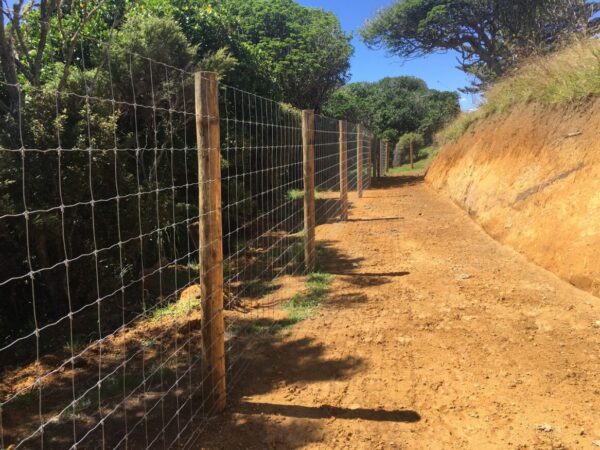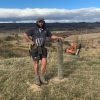
Most farm fencing is about keeping valuable livestock in. But increasingly, fencing is being installed to keep pest animals out.
Last year, a 2-metre high deer fence was installed along 1.2km of undulating land on Brent and Antonia Mountfort’s sheep and beef farm at Manawahe, just up the coast from Matata.
It’s not that Brent, the Federated Farmers Bay of Plenty president, was diversifying into venison production. Instead, in a combined project with Bay of Plenty Regional Council and QEII National Trust, the Mountforts were out to protect 6ha of bush full of rimu and four or five different varieties of rata, including some quite rare specimens.
This 6ha is in addition to another 30ha already under covenant on their property, as well as gullies, slopes and relatively unproductive areas the Mountforts have augmented or entirely planted out themselves.
Brent says some of the other bush areas are conventionally fenced, and it’s not too difficult for feral deer, pigs, goats and wallabies to get in and out. The BOP council and QEII Trust came to the party over the latest $66,000 fencing job, not just because of the bush biodiversity values, but also to monitor just how much the higher and more robust fence offers by way of keeping out the pests.
The difference is already noticeable, Brent says.
“The deer fencing was only finished eight months ago, but I’m already seeing plants growing to an extent I don’t see in the other bush blocks.
“It’s quite incredible how quickly the seedlings and ferns have come away because they’re not being chomped by feral deer.”
Brent credits fencing contractor Scott Graham of Specialist Rural Services with doing a “gold standard” job.
“It’s important to find the right fencer; we’re talking about a considerable capital expenditure. “I had a few come and look at the project, but Scott really impressed me. He wore me out walking the site and put a lot of effort into researching what was needed.”
The Mountfort’s wanted a traditional 13-wire fence rather than the increasingly common netting fence, out of concern that ewes and lambs could get their head stuck in the latter, and on quite a remote part of the farm, their predicament might not be noticed in time.
He’s loath to point the finger because he understands the funding constraints, but Brent says too many browsing ungulates are coming out of DOC and council public estate to graze bush and paddocks on farms.
“We’d be in even deeper trouble pest-animal wise if it wasn’t for the efforts of farmers, hunters, volunteers and organisations like QEII.
“It’s not just the cost of fencing, there’s all the money and time that goes into planting areas out.
“It’s hugely frustrating to dig in young trees and shrubs and do your bit on pest control, all the time knowing the pests are breeding on adjacent public land and are likely to re-invade,” Brent says.
Two farms away from the Mountforts, another landowner is also in the process of installing a deer fence to keep out ungulate invaders.
Just before last year’s general election, Federated Farmers joined with Forest & Bird NZ to urge political parties to boost control programmes targeting feral deer, pigs, goats and wallabies, to stop growing mobs of the pests undermining farmers’ livelihoods.
QEII Trust Team Leader Operational Services, Ben Johnston, says they’re also seeing the negative environmental impacts of rising feral ungulate numbers in the landscape.
In recent years, QEII covenantors on bigger stations on the East Coast of the North Island have reported herds of over 140 eating grass intended for sheep and cattle. Covenants that were in great condition in Canterbury have had years of regeneration chewed out in a few years. In Southland, one landowner removed 650 deer from their property over 18 months.
“We have heard reports from covenantors of feral ungulate pressure coming from adjacent council reserves and public conservation land, but the reality is that it is a landscape-wide issue that needs cooperation, leadership, investment and meaningful action to solve,” Ben says.
Fencing contractors and specialists have an obvious role.
QEII shares the cost of conventionally fencing new covenants equally with landowners. Due to pressure from feral ungulates, it’s becoming increasingly necessary to fence covenants with ungulate-proof fencing as opposed to ‘standard’ stock-proof fencing, which is considerably more expensive and often prohibitive for landowners.
Where landowners are willing to install ungulate-proof fencing and agree to permanent exclusion of domestic and feral ungulates from the protected area, QEII will share fencing costs 60:40.
“We’re also supporting existing covenantors to “top-up” their existing stock-proof fencing to deer-fencing through our contestable fund, the Stephenson Fund, and through our Jobs for Nature-funded deer exclusion project,” Ben says.
QEII was fortunate to receive $2 million of Jobs for Nature funding via DOC, to deer-fence and eradicate deer from selected, already established covenants where feral deer exclusion is considered the highest priority management intervention. It involves engaging fencing and ungulate-culling contractors to exclude pest deer and upgrade conventional fencing to deer-proof status in participating covenants.
Article written by Federated Farmers of New Zealand
Published in the Animal Enclosures feature of WIRED issue 73/JUNE 2024 by Fencing Contractors Association NZ
Follow us on Facebook
© Fencing Contractors Association NZ (FCANZ)














